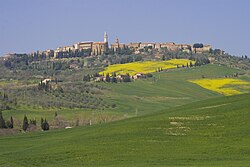Pienza
Pienza, a town (it: commune) in the province of Siena, in the Val d'Orcia in Tuscany (central Italy), between the towns of Montepulciano and Montalcino, is the "touchstone of Renaissance urbanism."[3]
Pienza | |
|---|---|
| Comune di Pienza | |
 | |
| Coordinates: 43°04′43″N 11°40′44″E / 43.07861°N 11.67889°E | |
| Country | Italy |
| Region | Tuscany |
| Province | Siena (SI) |
| Frazioni | Cosona, La Foce, Monticchiello, Palazzo Massaini, Spadaletto |
| Government | |
| • Mayor | Manolo Garosi |
| Area | |
| • Total | 122.96 km2 (47.48 sq mi) |
| Elevation | 491 m (1,611 ft) |
| Population (28 February 2017)[2] | |
| • Total | 2,091 |
| • Density | 17/km2 (44/sq mi) |
| Demonym | Pientini |
| Time zone | UTC+1 (CET) |
| • Summer (DST) | UTC+2 (CEST) |
| Postal code | 53026 |
| Dialing code | 0578 |
| Patron saint | St. Andrew the Apostle |
| Saint day | November 30 |
| Website | Official website |
| Official name | Historic Centre of the City of Pienza |
| Criteria | Cultural: (i)(ii)(iv) |
| Reference | 789 |
| Inscription | 1996 (20th Session) |
| Area | 4.41 ha (10.9 acres) |
In 1996, UNESCO put the town his list as a World Heritage Site, and in 2004 the all valley, the Val d'Orcia, was put on the list of UNESCO's World Cultural Landscapes.
History
changePienza was rebuilt from a village called Corsignano, which was the birthplace (1405) of Aeneas Silvius Piccolomini (Italian: Enea Silvio Piccolomini), a Renaissance humanist born into an exiled Sienese family, who later became Pope Pius II. Once he became Pope, Piccolomini had the entire village rebuilt as an ideal Renaissance town. Intended as a retreat from Rome, it represents the first application of humanist urban planning concepts.The rebuilding was done by Florentine architect Bernardo Gambarelli (known as Bernardo Rossellino).
Important Places and Monuments in Pienza
changePalazzo Piccolomini
changeThe piazza is made by four buildings. The principal residence, Palazzo Piccolomini, is on the west side.
The Duomo
changeThe Duomo (Cathedral), which dominates the center of the piazza, has a façade that is one of the earliest designed in the Renaissance manner. Artworks in the Duomo include five altar paintings from the Sienese School. The Baptistry, dedicated as usual to San Giovanni.
Palazzo Borgia
changeThe Palazzo Borgia, on the third side of the piazza, was built as the palace to house the bishops who would travel to Pienza to attend the Pope. Inside the palace there is the Diocesan Museum, and the Museo della Cattedrale. The collection includes a lot of religious artifacts. Paintings include a 7th-century painting of Christ on the Cross (La Croce), 14th century works by Pietro Lorenzetti (Madonna with Child) and Bartolo di Fredi (Madonna della Misericordia). There are also important works from the 14th and 15th centuries, including a Madonna attributed to Luca Signorelli.
Palazzo Comunale
changeAcross from the church is the town hall. Since Corsigniano was originally a village without a town governance, before the transformations there was no town hall. But when Corsigniano was given the status of an official city, a Palazzo Comunale was required. A third floor was added in 1599. The Palazzo Comunale was probably also designed by Rossellino.
Other buildings
change- Ammannati Palace
- The Gonzaga Palace
- The Palazzo del Cardinale Atrebatense
- The Pieve of Corsignano, in the neighbourhood, is one of the most important Romanesque monuments of the area.
Related pages
changeReferences
change- Mack, Charles (1987). Pienza: the Creation of a Renaissance City. Ithaca: Cornell University Press. ISBN 9780801416996.
- Tönnesmann, Andreas (1990). Pienza: Städtebau und Humanismus. Munich: Hirmer.
- Pieper, Jan (1997). Pienza: der Entwurf einer humanistischen Weltsich. Stuttgart: Axel Menges.
Notes
change- ↑ "Superficie di Comuni Province e Regioni italiane al 9 ottobre 2011". Italian National Institute of Statistics. Retrieved 16 March 2019.
- ↑ "Popolazione Residente al 1° Gennaio 2018". Italian National Institute of Statistics. Retrieved 16 March 2019.
- ↑ Nicholas Adams, "The Acquisition of Pienza 1459-1464" The Journal of the Society of Architectural Historians 44.2 (May 1985), pp. 99-110. Adams details the piecemeal acquisition of parcels of land by Pius II.
Other websites
change- Piazza Pio II Archived 2007-09-27 at the Wayback Machine
- Hometown Pope Makes Good (Pope Pius II and Pienza) by Charles T. Downey (Ionarts, 24 August 2006)



